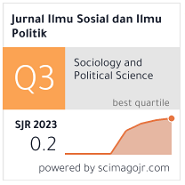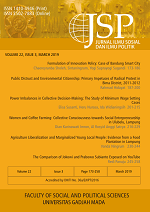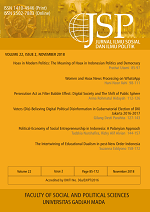A Contested Identity: Contemporary Representation of Indonesian Chinese-Muslims on Instagram
Jesslyn Giovanni Mulyanto(1*)
(1) Department of Communication, Universitas Airlangga, Indonesia
(*) Corresponding Author
Abstract
The existence of Chinese Muslims in Indonesia is surrounded by a heavily prejudiced belief that Chinese-ness and Islam are considered "unsuitable". Chinese Muslims, particularly 'converts- turned-preachers', are still considered a unique identity. However, the rise of online Islamic piety on Instagram has become one of many ways for Chinese Muslims' to represent themselves and, to some extent, "normalize" their identities. This paper discusses how Chinese-Muslim preachers, namely Felix Siauw and Koko Liem, represent their versions of Chinese-ness and Islam on Instagram, a popular visual-based social media platform in Indonesia. This research uses Multimodal Discourse Analysis (MDA) to observe the preachers' identity narratives and ways to articulate their Chinese-ness and Islam on their respective accounts posts. It is shown that the heterogeneous stances and contesting interpretations on and about Chinese-ness and Islam in the Chinese-Muslim minority group are to some extent represented through the visual appearance and narrative on Instagram of both preachers. From these two figures, the researcher concludes that elements of Islamic religious identity tend to dominate and even fade ethnic Chinese identity in the negotiations between Chinese and Muslim identities. However, their Chinese-ness was strategically used and symbolically commodified to attract the masses. These two preachers become part of the heterogeneous spectrum of Chinese-Muslim representation in Indonesia and the "pavement" for a common image of the combination of the two identities in Indonesia.
Keywords
Full Text:
PDFReferences
Al-Qurtuby, S. (2009). The Tao of Islam: Ceng Ho and the Legacy of Chinese Muslims in Pre-Modern Java. Studia Islamika, 16(1). https://doi.org/10.15408/sdi.v16i1.489
Arifianto, A. R. (2019). Rising Islamism and the Struggle for Islamic Authority in Post-Reformasi Indonesia. TRaNS: Trans- Regional and -National Studies of Southeast Asia, 1–14. https://doi.org/10.1017/trn.2019.10
Arifin, E. N., Hasbullah, M. S., & Pramono, A. (2017). Chinese Indonesians: how many, who and where? Asian Ethnicity, 18(3), 310–329. https://doi.org/10.1080/14631369.2016.1227236
Badan Pusat Statistik. (2020). Berita Resmi Statistik: Hasil Sensus Penduduk 2020. In Badan Pusat Statistik. https://papua. bps.go.id/pressrelease/2018/05/07/336/ indeks-pembangunan-manusia-provinsi- papua-tahun-2017.html
Eifert, Y. (2012). Conflict Formation and Transformation in Indonesia: Chinese and Indigenous Indonesians on Their Way to Peace? A Peace and Conflict Analysis According to the Transcend Method. University of Giessen, 290.
Fajri, D. L. (2022). 12 Orang Terkaya di Indonesia Versi Forbes - Nasional Katadata.co.id. Katadata.Co.Id. https://katadata.co.id/ agung/berita/623d687aae49a/12-orang- terkaya-di-indonesia-versi-forbes
Heidhues, M. S. (1972). Dutch Colonial and Indonesian Nationalist Policies Toward the Chinese Minority in Indonesia. Verfassung Und Recht in Übersee / Law and Politics in Africa, Asia and Latin America, 5(3), 251–261.
Heidhues, M. S. (2012). Anti-Chinese violence in Java during the Indonesian Revolution, 1945–49. Journal of Genocide Research, 14(3–4), 381–401. https://doi.org/10.1080/14623528.2012.719371
Hew, W. W. (2017). Diversity not Uniformity: Chinese Muslim Preachers and Politicians in Indonesia. ISEAS Perspective, 45, 1–6.
Hew, W. W. (2018a). Chinese Ways of Being Muslim: Negotiating Ethnicity and Religiosity in Indonesia. NIAS Press.
Hew, W. W. (2018b). THE ART OF DAKWAH: social media, visual persuasion and the Islamist propagation of Felix Siauw. Indonesia and the Malay World, 46(134), 61–79. https://doi.org/10.1080/13639811.2018.1416757
Hoon, C.-Y. (2006). Reconceptualising Ethnic Chinese Identity in Post-Suharto Indonesia. The University of Western Australia.
Hoon, C.-Y. (2008). Chinese Identity in Post Soeharto Indonesia: Culture, Politics, Media. Sussex Academic Press.
Huang, Q. (2011). A Study on the Metaphor of “Red” in Chinese Culture. American International Journal of Contemporary Research, 1(3), 99–102. http://aijcrnet.com/journals/Vol_1 _ No_3 _November_2011/13.pdf
Husein, F., & Slama, M. (2018). Online piety and its discontent: revisiting Islamic anxieties on Indonesian social media. Indonesia and the Malay World, 46(134), 80–93. https:// doi.org/10.1080/13639811.2018.1415056
Jancsary, D., Hollerer, M., & Meyer, R. (2016). Critical analysis of visual and multimodal texts. In R. Wodak & M. Meyer (Eds.), Methods ofCritical Discourse Studies (3rd ed., Issue March, pp. 180–204). SAGE.
Jones, C. (2021). Mualaf Chic : Conversion and Mediation in Indonesian Pious Sociality. CyberOrient, 15(1), 172–205.
Khairina, U. (2020). Strategi Komunikasi Islam Felix Siauw di Instagram. Jurnal Peurawi:Media Kajian Komunikasi Islam, 3(2), 14–26.
Lombard, D. (2005). Nusa Jawa: Silang Budaya (Jaringan Asia) (Cetakan Ke). PT Gramedia Pustaka Utama.
Lombard, D., & Salmon, C. (1993). Islam and Chineseness. Indonesia, 57(April 1993), 115–131.http://www.jstor.com/stable/3351244
Meta. (2022). What is a verified badge on Instagram? | Instagram Help Centre. https://help.instagram.com/733907830039577
Musa, M. F. (2020). Social Media Preachers : Unlicenced and Unbounded in Spreading Their Ideas. 146, 1–23.
Mustapha, M., & Abdul Razak, M. A. (2019). A Contrastive Analysis of Yusuf Islam and Zakir Naik’s Styles of Religious Propagation (or Preaching). Al-Itqan: Journal of Islamic Sciences and Comparative Studies , 3 (2), 65–86. https://doi. org/10.31436/al-itqan.v4i2.130
Panggabean, S. R., & Smith, B. (2011). Explaining Anti-Chinese Riots in Late 20th Century Indonesia. World Development, 39(2), 231–242. https://doi.org/10.1016/j.worlddev.2009.11.036
Purdey, J. (2002). Anti-Chinese Violence in Indonesia, 1996-1999. The University of Melbourne.
Reid, A. (2009). Escaping the burdens of Chineseness. Asian Ethnicity , 10 (3), 285–296. https://doi.org/10.1080/14631360903189666
Retiyanti, D. W. (2020). MAKNA MOTIF DAN WARNA KAIN BATIK. Prajnaparamita, 9, 65–75.
Sai, S. M., & Hoon, C.-Y. (2012). Chinese indonesians reassessed. Chinese Indonesians Reassessed, 9780203095, 1–226. https://doi.org/10.4324/9780203095362
Sakai, M., & Fauzia, A. (2014). Islamic orientations in contemporary Indonesia: Islamism on the rise? Asian Ethnicity, 15(1), 41–61. https://doi.org/10.1080/14631369.2013.784513
Schwartz, S. J., Luyckx, K., & Vignoles, V. L. (2011). Handbook of Identity Theory and Research. In Handbook of Identity Theory and Research. https://doi.org/10.1007/978-1-4419-7988-9
Setijadi, C. (2019). Anti-Chinese sentiment and the ‘return’ of the pribumi discourse. In Contentious Belonging: The Place of Minorities in Indonesia (pp. 194–213). https://doi.org/10.1355/9789814843478-015
Shiraishi, T. (1997). Zaman Bergerak; Radikalisme Rakyat di Jawa, 1912-1926 (E. N. Pertiwi (ed.); Cetakan Pe). PT Pustaka Utama Grafiti.
Slama, M. (2018). Practising Islam through social media in Indonesia. Indonesia and the Malay World, 46(134), 1–4. https://doi. org/10.1080/13639811.2018.1416798
Suryadinata, L. (1976). Indonesian Policies toward the Chinese Minority Under the New Order. Asian Survey, 16(8), 770–787. https://doi.org/10.2307/2643578
Suryadinata, L. (1999). Negara dan Minoritas Tionghoa di Indonesia. Wacana, 1(2), 223–247. https://doi.org/10.17510/wjhi.v1i2.297
Suryadinata, L. (2019). Zheng He as the Symbol of Chinese Muslims in Indonesia. NSC Highlights, 12. https://doi.org/10.21900/j. jloe.v1i1.756
Tsai, Y. (2018). Pilgrimage and Hui Muslim Identity in the Republican Era. In C. Kuo (Ed.), Religion and Nationalism in Chinese Societies (pp. 179–196). Amsterdam University Press. https://doi.org/10.2307/j. ctt1zkjzkd.10
Veum, A., & Undrum, L. V. M. (2017). The selfie as a global discourse. Discourse and S ociety , 00 (0), 1–18. https://doi. org/10.1177/0957926517725979
Article Metrics
Refbacks
- There are currently no refbacks.
Copyright (c) 2022 Jurnal Ilmu Sosial dan Ilmu Politik

This work is licensed under a Creative Commons Attribution-NonCommercial-NoDerivatives 4.0 International License.






















